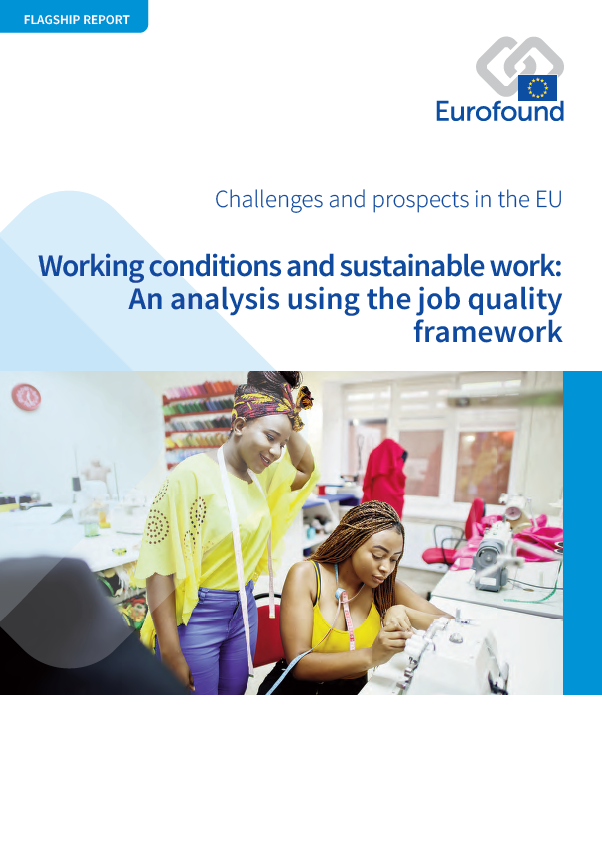
See juhtaruanne võtab kokku programmiperioodil 2017–2020 tehtud Eurofoundi töötingimuste uuringute peamised järeldused. Selles kaardistatakse alates 2000. aastast tehtud edusammud töötingimuste parandamisel ja vaadeldakse, kas kõik töötajad on positiivsetest muutustest võrdselt kasu saanud. Aruandes tuuakse välja, mis rühmadel on kõige suurem oht kogeda halbu töötingimusi ja mahajäetust Arvestades muutusi töömaailmas, tehakse kindlaks hea töökvaliteedi uued väljakutsed. Aruandes esitatakse ka tõendid meetmetest, mis aitavad saavutada ELis veelgi parema töökeskkonna ja kõigi jaoks õiglased töötingimused.
Analüüs näitab, et töökvaliteet ELis paraneb, kuigi aeglaselt. Kõik töötajad ei saa aga muutustest võrdselt kasu. Lisaks on sool, vanusel ja lepingulisel seisundil oluline mõju töötingimustele. Kuigi digiteerimine aitab lahendada mõningaid töökvaliteedi probleeme, loob see ka uusi väljakutseid. COVID-19 pandeemia on suundumusi võimendanud, tuues rohkem esile probleeme ja rõhutades kõigi jaoks töökvaliteedi saavutamise tähtsust.
Key findings
Praegu on ELi töötajatel keskmiselt paremad töötingimused kui aastatuhande alguses. Selgelt on paranenud tööaja kvaliteet, kuid parem on ka füüsiline keskkond, eriti ametikohtadel, kus füüsilised ohud on suured.
Töökohad nõuavad tänapäeval rohkem oskusi ja pakuvad suuremat autonoomsust kui varem. See kajastub oskuste ja kaalutlusindeksi paranemises.
Töötajate oskuste arengut takistab ebavõrdne juurdepääs tööandja tasustatud koolitustele ja nende rakendamine. Vanemad töötajad osalevad koolitustel vähem ning kasvab koolituste kättesaadavuse lõhe erineva lepingulise staatusega (täistööaeg vs. osaline tööaeg ja alaline või tähtajaline leping) töötajate vahel.
Tööturul püsiv sooline segregatsioon kajastub meeste ja naiste töökvaliteedi erinevustes. Üht võitjat siin aga pole. Soolised erinevused võivad kahjustada ka mehi, nt füüsilise keskkonna osas.
Kuigi karjäärivõimalused on üldiselt paranenud nii meeste kui ka naiste jaoks, on mehed säilitanud eelise selles töökvaliteedi dimensioonis. Tõenäoline põhjus on hoolduskohustuste ebavõrdne jaotus, mis väljendub naiste pikemates karjääripausides ja erinevas tööaja korralduses.
Based on the European Working Conditions Survey (EWCS) 2015 analysis, the data below accompany Eurofound's flagship report on working conditions and sustainable work and focus on job quality for different occupational profiles.
- Data: Job quality in the EU
The flagship report also has the following list of tables and figures.
List of tables
Table 1: Change in the composition of the workforce, EU27 and the UK, 2002–2019
Table 2: Elements of the job demands–resources model based on the EWCS
List of figures
Figure 1: The seven dimensions of job quality and the indicators composing each dimension
Figure 2: Indexed change in job quality indices, EU27 and the UK, 2000–2015
Figure 3: Physical environment index: mean and standard deviation, by occupational category, EU27 and the UK, 2000–2015
Figure 4: Work intensity index: mean and standard deviation, by sector, EU27 and the UK, 2000–2015
Figure 5: Work intensity index: mean and standard deviation, by country cluster, EU27 and the UK, 2000–2015
Figure 6: Skills and discretion index: mean and standard deviation, by occupational category, EU27 and the UK, 2000–2015
Figure 7: Skills and discretion index: mean and standard deviation, by country cluster, EU27 and the UK, 2000–2015
Figure 8: Participation in paid training (%), by employment and contractual status, EU27 and the UK, 2005–2015
Figure 9: Associations between working time quality and occupational category, by country cluster
Figure 10: Working time quality index: mean and standard deviation, by country cluster, EU27 and the UK, 2000–2015
Figure 11: Long working hours (%), by employment status, EU27 and the UK, 2000–2015
Figure 12: Prospects index: mean and standard deviation, by occupational category, EU27 and the UK, 2005–2015
Figure 13: Prospects index: mean and standard deviation, by country cluster, EU27 and the UK, 2005–2015
Figure 14: Scores on Prospects index, by employment and sociodemographic characteristics, EU27 and the UK, 2005 and 2015
Figure 15: Receipt of support from colleagues and managers (%), EU27 and the UK, 2005–2015
Figure 16: Receipt of support from colleagues and managers (%), by age group, EU27 and the UK, 2005 and 2015
Figure 17: Exposure to adverse social behaviour (%), by gender, EU27 and the UK, 2010 and 2015
Figure 18: Perception of fair pay (%), by Member State and the UK, 2005–2015
Figure 19: Perceived appropriateness of pay, by country cluster, EU27 and the UK, 2005–2015
Figure 20: Job quality profiles: Scores on seven job quality indices, EU27 and the UK, 2015
Figure 21: Distribution of workers according to job quality profiles, EU27 and the UK, 2015
Figure 22: Job quality profiles of men, by job quality indices, EU27 and the UK, 2015
Figure 23: Job quality profiles of women, by job quality indices, EU27 and the UK, 2015
Figure 24: Distribution of employees according to predominant gender in occupation (%), by gender, EU27 and the UK, 2010 and 2015
Figure 25: Gender of immediate manager (%), by worker’s gender, EU27 and the UK, 2005–2015
Figure 26: Female employees reporting good prospects for career advancement and gender gap (%), EU27 and the UK, 2005–2015
Figure 27: Good prospects for career advancement (%), by age and gender, EU27 and the UK, 2005–2015
Figure 28: Job insecurity according to predominant gender in occupation (%), by gender, EU27 and the UK, 2010 and 2015
Figure 29: Employability according to predominant gender in occupation (%), by gender, EU27 and the UK, 2010 and 2015
Figure 30: Employees reporting difficulty making ends meet according to occupation type (%), by gender, EU27 and the UK, 2015
Figure 31: Employees reporting difficulty making ends meet according to household type (%), by gender, EU27 and the UK, 2015
Figure 32: Employee experience of selected emotional demands (%), by gender, EU27 and the UK, 2010 and 2015
Figure 33: Average weekly working hours of employees across the life course, by gender, EU27 and the UK, 2015
Figure 34: Flexibility to take time off according to predominant gender in occupation (%), by gender, EU27 and the UK, 2010 and 2015
Figure 35: Additional components of earnings from main job (%), by gender, EU27 and the UK, 2005–2015
Figure 36: Employees’ perception of their work–life balance (%), by age, EU27 and the UK, 2015
Figure 37: Employees’ participation in training (%), by age and training classification, EU27 and the UK, 2015
Figure 38: Associations between demands and resources and workers’ health and well-being
Figure 39: Proportion of workers with flexitime schedules and engaged in TICTM (%), EU27 and the UK, 2015
Figure 40: Workers reporting work–life balance problems (%), by work arrangement and presence or absence of children, EU27 and the UK, 2015
Figure 41: Multiple-job holders as a proportion of total employment (%), by gender and country, EU27 and the UK, 2018
Figure 42: Job quality profiles of multiple-job holders’ main jobs, by gender, EU27 and the UK, 2015
Figure 43: Job quality of selected critical occupations in relation to the workforce average
Figure 44: Emotional demands on ISWs and extent of those demands (%), EU27 and the UK, 2015
- Number of pages
-
80
- Reference nº
-
EF20021
- ISBN
-
978-92-897-2150-9
- Catalogue nº
-
TJ-03-21-030-EN-N
- DOI
-
10.2806/938302
- Permalink
Members of Eurofound’s Management Board provide their reactions to and insights into Eurofound’s 2021 flagship report on Working conditions and sustainable work: An analysis using the job quality framework.
- Impact of the Covid-19 pandemic
Interview with Juha Antila, Head of Research and Development SAK, Central Organisation of Finnish Trade Unions.
- Digitalisation
Interview with Mario van Mierlo, Deputy Director, Social Affairs, The Dutch Confederation of Industry and Employers (VNO-NCW).
- Making work sustainable
Interview with Alain Piette, Ergonomist at the Belgian Federal Public Service Employment, Labour and Social Dialogue.
- Role of different actors in improving job quality
Interview with Rebekah Smith, Deputy Director for Social Affairs, BusinessEurope.
- Persisting challenges
Interview with Nelson Ferreira, Deputy General Inspector ACT, Portugal Labour Conditions Authority.
- Remote working
Interview with Esther Lynch, Deputy General Secretary of the European Trade Union Confederation (ETUC).
Cite this publication
Eurofound (2021), Working conditions and sustainable work: An analysis using the job quality framework, Challenges and prospects in the EU series, Publications Office of the European Union, Luxembourg.
